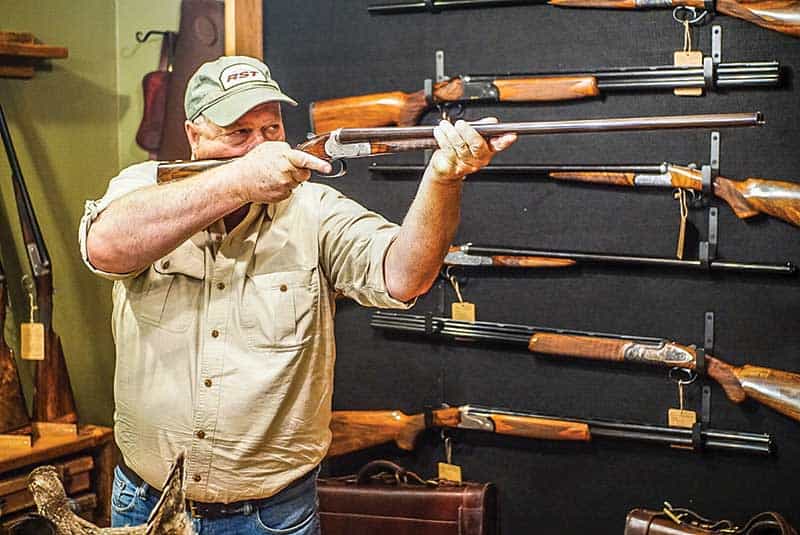(Gun) Fit Is It
A Good Foundation Is Key
Once upon a time, and not so long ago, you wouldn’t have one in your safe. Gun stocks were shaped like the working end of a hockey stick. They were designed specifically with the new shooter in mind — the soldiers returning from World War I.
But those GIs were not schooled shotgunners, they were riflemen well acquainted with shooting techniques learned from using a Springfield 1903 or an M1917 Enfield. The high head/drop-stocked technique was in vogue and shotguns with short length-of-pull and significant drop at comb and heel became the norm. Give one to a modern hunter and he likely won’t hit squat. Never underestimate the importance of a proper gun fit.
The Goal
“A shotgun fit’s only objective is to achieve proper pupil position over the barrel rib,” says Lars Jacob of Lars Jacob Wingshooting. Jacob is no stranger to seeing improved shooting through proper gun fit. He’s one of the country’s foremost gunfitters and has performed over 3,500 fittings for over 35 years. “A shooter with a good cheek and shoulder weld hits more birds because the combination results in a firm anchor point. Most Americans don’t give a lot of thought to gun fittings because nearly all of our shotguns have always been available as off-the-rack options. In the United Kingdom and in Europe, nearly all shotguns are custom made.”
Proper fit takes three fundamental wingshooting dynamics into account. “Pointability is most important for shotgunning, and that comes through balance,” says Jacob. “Levelness of swing is important so folks shoot at the target and not above or below it. Lastly, a shotgun works best if it is an extension of the body. If you’ve ever struggled with shooting a shotgun then you know what I’m talking about.”
Shooting styles changed beginning in the 1950s. Wide stances were replaced with narrower foot positions allowing for greater range of movement. More relaxed arm positions, square shoulders and forward head positions were used to create flatter swings, which required longer and flatter measurements.
Today’s shooters are far more responsive to targets and birds than ever before. Shotgun lengths that used to be in the 13 ¾” to 14 ¼” range now appear in the 14 ½” range or longer. “I just received a customer’s Beretta Silver Pigeon and the stock measured 15″,” Jacob said. “Drops are flatter as well, and 1 ½” and 2 ½” are standard.”
Many scattergunners treat gun fit as if were a shirt size — rock what feels good. But after nearly 40 years, Jacob says that’s not true. “I can take two people of identical dimensions in terms of height, weight, chest size, arm length and the like and find them to have two different stock dimensions. After an hour and a half fitting with a try gun on a patterning board, we’ll shoot straight aways and crossers. The improvement in broken targets is significant.”
Pitch
About 90% of discussions are around fit and drop, but incorrect pitch and cast can cause shooters to miss. “Pitch is key to ensure the cheek falls naturally into the comb, that the butt fits in the fold of the shoulder and the eye is looking down the rib,” Jacob said. “If you look at the gun butt, and from the top of the heel to the bottom of the toe it measures 0 degrees, then you have no pitch.
“A 4-degree pitch is more common with an average chest size, the kind that would fit in a 42 regular blazer. Four degrees of pitch is commonly found on off-the-rack guns. A more muscular physique, the kind that fits in a 46 regular probably requires the toe to move forward to accommodate chest thickness. If the toe lands at an 84% angle, then you’ll have six degrees of positive pitch, and so on. The only time I’ll fit with negative pitch, which is where the toe moves out beyond the heel, is for a high driven bird shooter. That is a specialty fit that will be deadly on tall pheasant in Scotland but terrible for field shooting.”
Cast
Cast is an equally overlooked dimension, and it works in synch with pitch. “Cast is what works with pitch to nestle the butt of the gun into the pocket, which is inside the ball of the shoulder. That pocket is always at an angle; how much depends on the individual. The amount of cast helps to push the stock out, so the eye is correctly lined up with the rib. Right-handed shooters should always have cast off, which is when the toe of the gun of a right-handed shooter angle to the right. Cast on is when the toe of the gun of a left-handed shooter angle also to the right. By positioning the stock correctly on the shooter’s body, cast working with pitch helps reduce muzzle flip. Muzzle flip is the recoil that comes after the first shot. The incorrect amount of cast as well as pitch allows the butt to twist slightly because the mount isn’t secure. The second shot is off, and if there is a third shot, it’s off even more.”
One of the reasons we shotgunners reach for a specific gunning iron over another is because we hit with it. The stars align, and chokes are right, loads are matched and our technique is spot on. But fit is the foundation of it all, so if you’re in the market for a new or used shotgun, start with a professional gun fit from an expert like Jacob. You’ll be able to measure the new prospect and know if it’s going to be your new, go-to shotgun.







